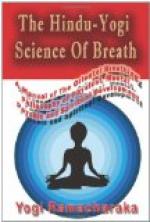The ribs are moved in respiration by two superficial muscular layers, known as the intercostal muscles. The diaphragm, the muscular partition before alluded to, separates the chest box from the abdominal cavity.
In the act of inhalation the muscles expand the lungs so that a vacuum is created and the air rushes in in accordance with the well known law of physics. Everything depends upon the muscles concerned in the process of respiration, which we may as, for convenience, term the “respiratory muscles.” Without the aid of these muscles the lungs cannot expand, and upon the proper use and control of these muscles the Science of Breath largely depends. The proper control of these muscles will result in the ability to attain the maximum degree of lung expansion, and the greatest amount of the life giving properties of the air into the system.
The Yogis classify Respiration into four general methods, viz:
(1) High Breathing.
(2) Mid Breathing.
(3) Low Breathing.
(4) Yogi Complete Breathing.
We will give a general idea of the first three methods, and a more extended treatment of the fourth method, upon which the Yogi Science of Breath is largely based.
(1) High breathing.
This form of breathing is known to the Western world as Clavicular Breathing, or Collarbone Breathing. One breathing in this way elevates the ribs and raises the collarbone and shoulders, at the same time drawing in the abdomen and pushing its contents up against the diaphragm, which in turn is raised.
The upper part of the chest and lungs, which is the smallest, is used, and consequently but a minimum amount of air enters the lungs. In addition to this, the diaphragm being raised, there can be no expansion in that direction. A study of the anatomy of the chest will convince any student that in this way a maximum amount of effort is used to obtain a minimum amount of benefit.
High Breathing is probably the worst form of breathing known to man and requires the greatest expenditure of energy with the smallest amount of benefit. It is an energy-wasting, poor-returns plan. It is quite common among the Western races, many women being addicted to It, and even singers, clergymen, lawyers and others, who should know better, using it ignorantly.
Many diseases of the vocal organs and organs of respiration may be directly traced to this barbarous method of breathing, and the straining of delicate organs caused by this method, often results in the harsh, disagreeable voices heard on all sides. Many persons who breathe In this way become addicted to the disgusting practice of “mouth-breathing” described in a preceding chapter.
If the student has any doubts about what has been said regarding this form of breathing, let him try the experiment of expelling all the air from his lungs, then standing erect, with hands at sides, let him raise the shoulders and collar-bone and inhale. He will find that the amount of air inhaled far below normal. Then let him inhale a full breath, after dropping the shoulders and collar-bone, and he will receive an object lesson in breathing which he will be apt to remember much longer than he would any words, printed or spoken.




